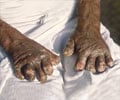- Around 2,11,973 new cases of leprosy were detected in 2015 worldwide. The cases were especially located in South East Asian and African countries as well as Brazil
- India reported 1,27,326 cases in 2015, the highest number noted in any country
- Worldwide, 271 children diagnosed with leprosy in 2015 had a disability at the time of diagnosis.
However, statistics indicate that we are still some distance away from complete eradication of the disease. Below are some of the figures from 2015:
- The worldwide prevalence of leprosy is 0.2 cases per 10,000 people
- Worldwide, 2,11,973 new cases were detected in 2015 (2.9 new cases per 1,00,000 people), which indicates that transmission still occurs. However, there may be still unreported or undiagnosed cases which could increase the number
- New cases are particularly located in the Asian countries of India, Indonesia, Bangladesh, Myanmar, Nepal, the Philippines and Sri Lanka, the African nations of DR Congo, Ethiopia, Madagascar, Mozambique, Nigeria, Tanzania and Brazil. These countries reported more than a 1,000 new cases in 2015
- The most number of cases 1,27,326 were reported from India, which indicates the need for a continuous effort to persevere in the efforts to conquer the infection. Medications for leprosy are provided free of cost in government health centers.
Some of the steps that can be taken on World Leprosy Day 2017:
Increase the Awareness About the Condition:
- Many people are not aware that leprosy still exists, which could lead to a delay in diagnosis. People should be taught to recognize symptoms early that can help in early diagnosis and early institution of medications. A light, red or darker patch on the skin with lack of sensation and loss of hair over it could indicate leprosy. However, it must be noted that not all cases of light skin patches are due to leprosy.
- A complete course of treatment results in a complete cure of the condition. Some deformities can be addressed.
- Leprosy is like any other infection. In fact, it is among the least infectious diseases, since most people are immune to it and most patients are non-infectious. Even infectious patients become non-infectious within a week of starting treatment, quite often following the first dose. Therefore, it is not necessary to keep the patient isolated after beginning the treatment. The person should be included in the society and not treated as an untouchable
- Patients should receive adequate treatment. The importance of completing treatment should be emphasized to bring about a complete cure
- People with disabilities should be provided adequate vocational training and opportunities to earn a living
- Leprosy - (http://www.who.int/mediacentre/factsheets/fs101/en/)








